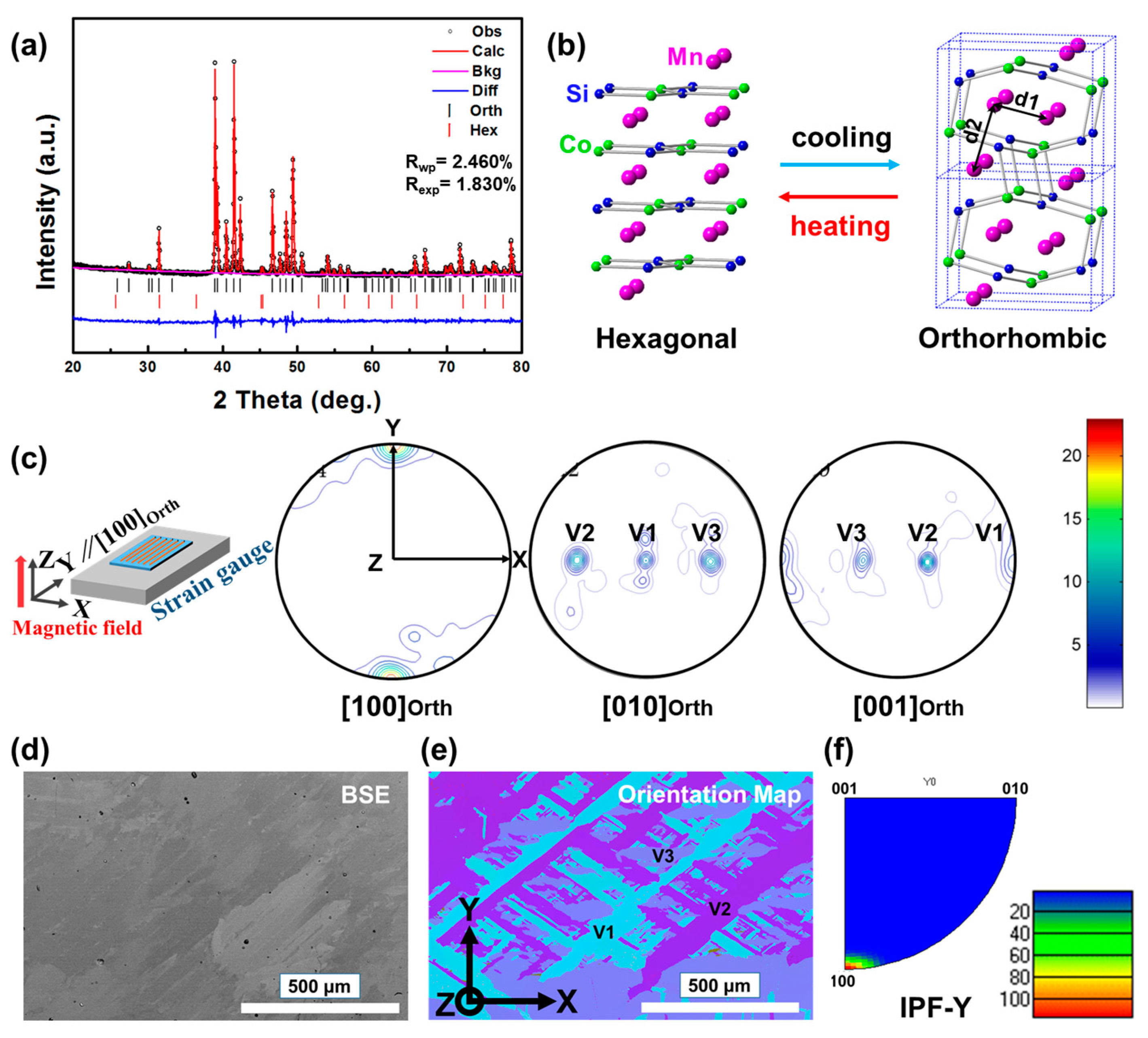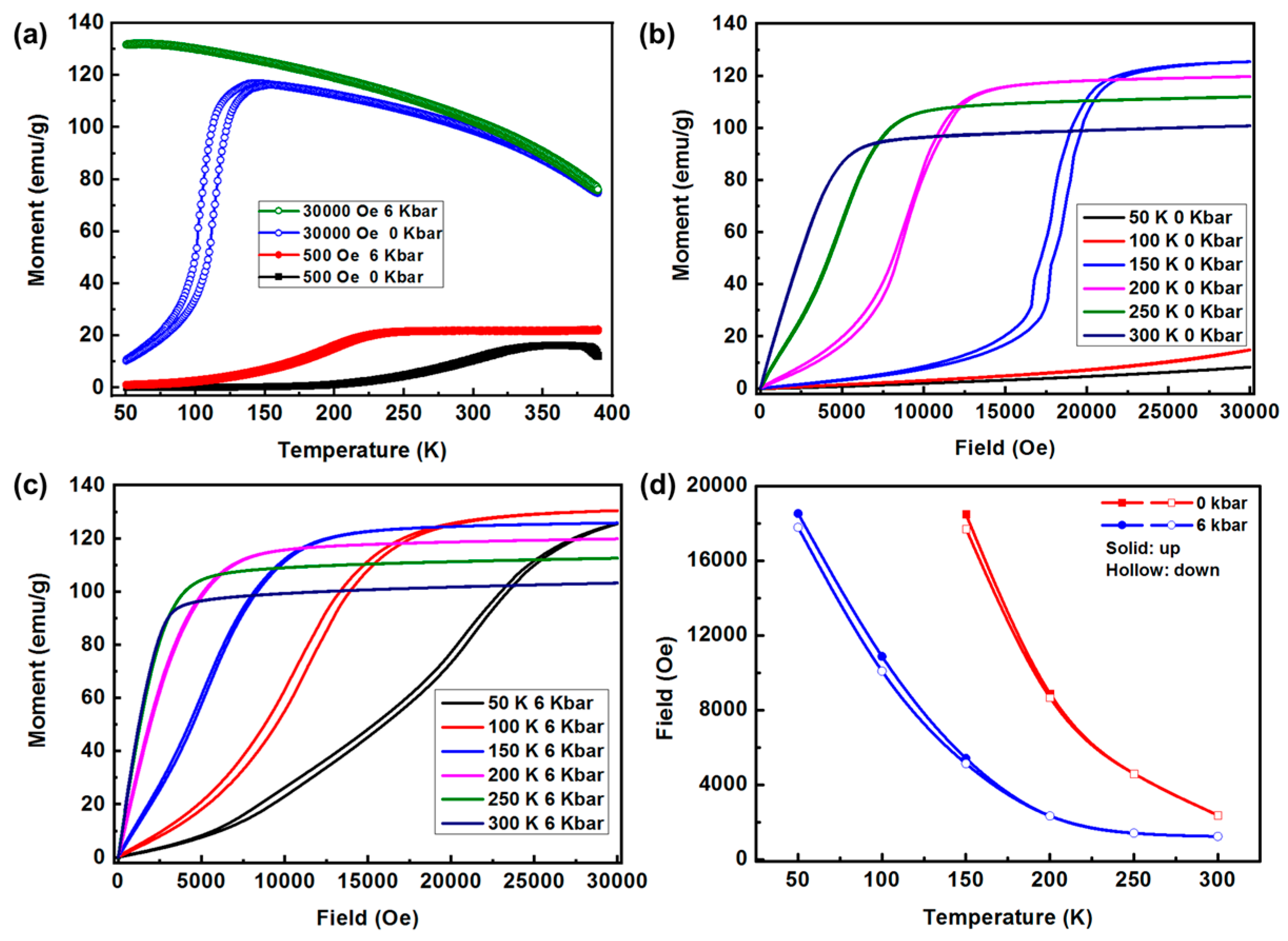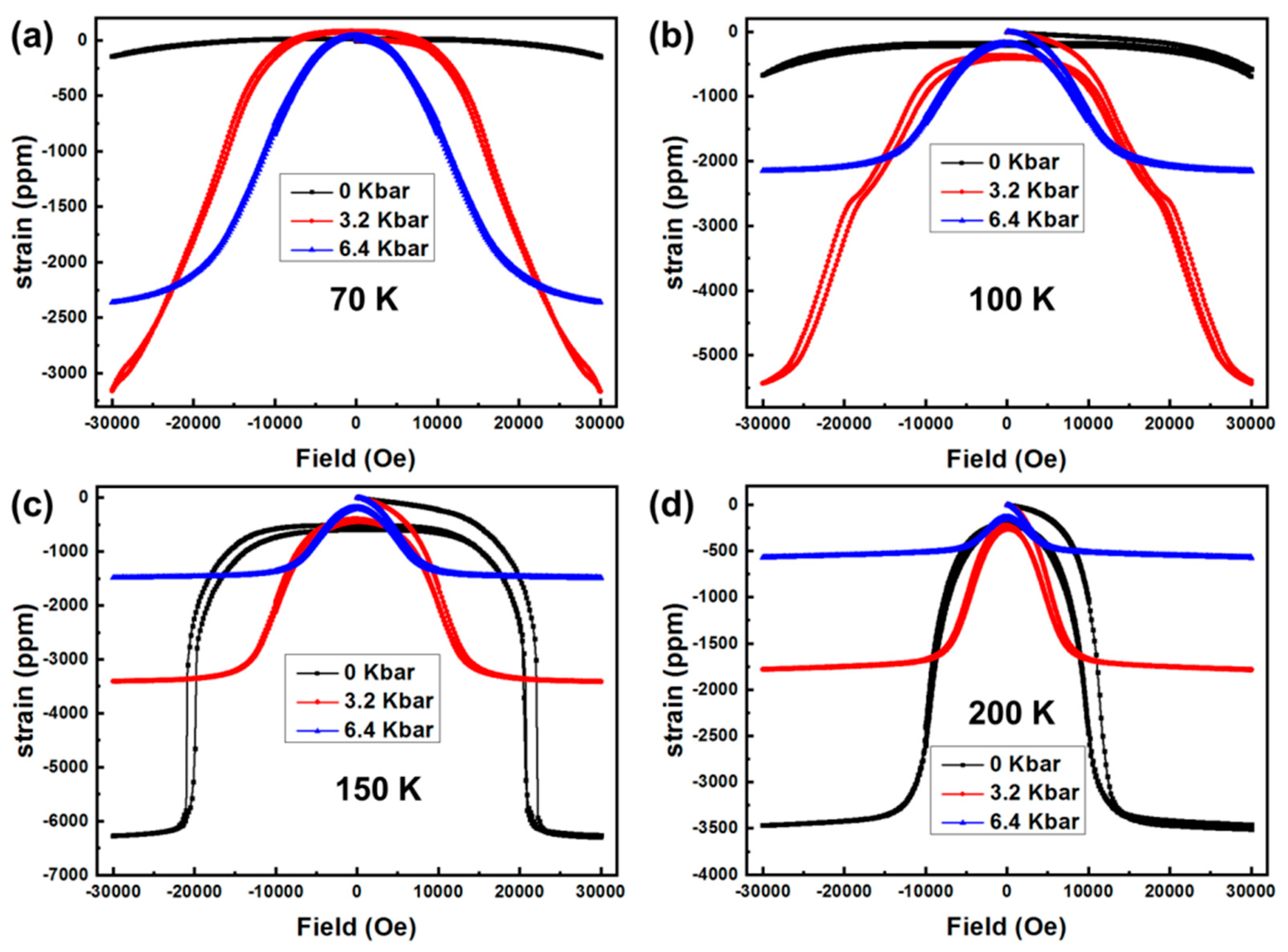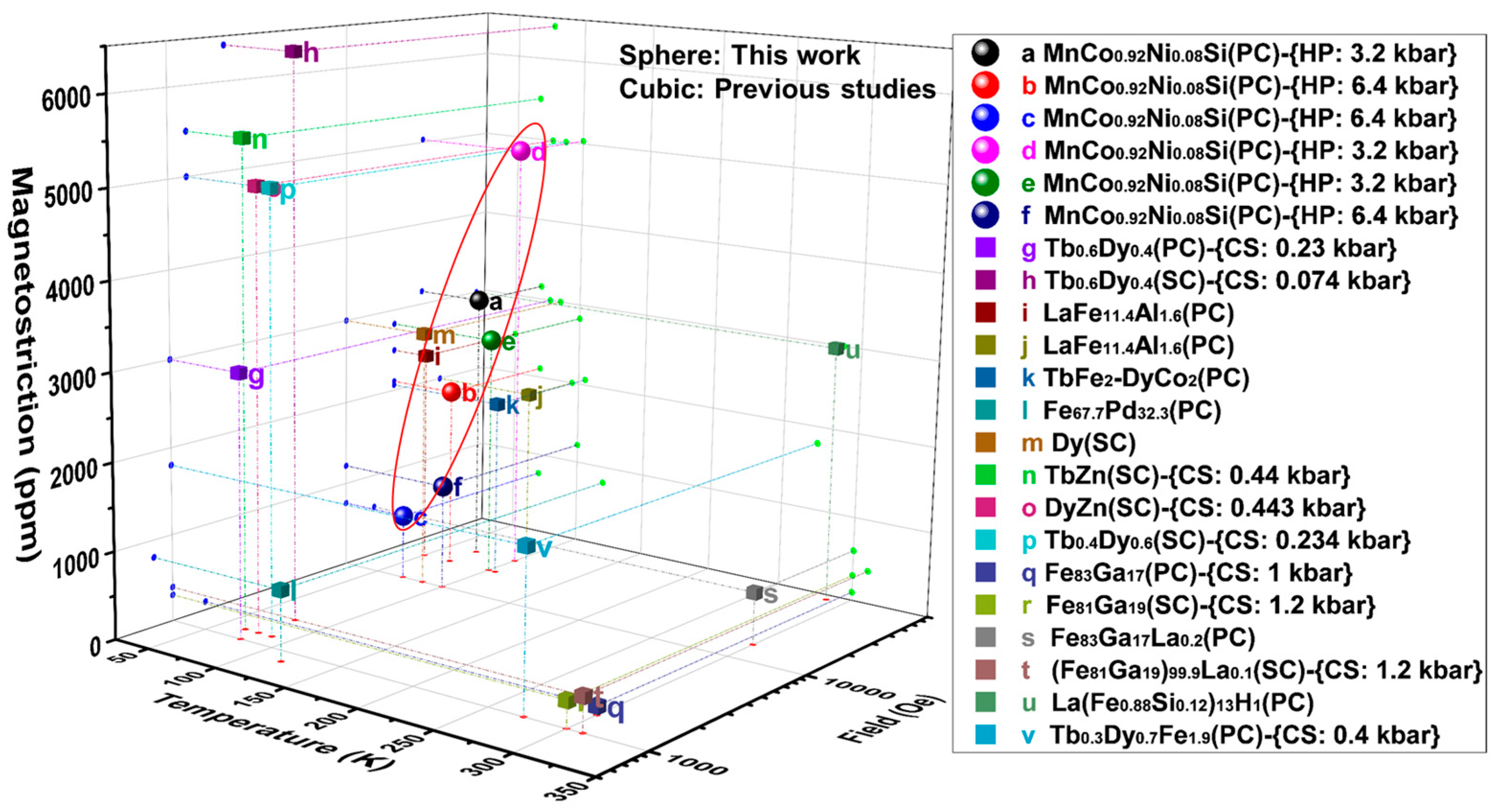Large Cryogenic Magnetostriction Induced by Hydrostatic Pressure in MnCo0.92Ni0.08Si Alloy
Abstract
1. Introduction
2. Materials and Methods
3. Results and Discussion
3.1. Crystal Structure, Macrostructure and Microstructure
3.2. Magnetic Properties
3.3. Magnetostriction
4. Conclusions
Author Contributions
Funding
Institutional Review Board Statement
Informed Consent Statement
Data Availability Statement
Conflicts of Interest
References
- Ma, T.Y.; Zhang, C.S.; Zhang, P.; Yan, M. Effect of magnetic annealing on magnetostrictive performance of a <110> oriented crystal Tb0.3Dy0.7Fe1.95. J. Magn. Magn. Mater. 2010, 322, 1889–1893. [Google Scholar]
- Jiang, C.B.; Zhang, H.B.; Wang, Z.B.; Xu, H.B. Magnetostriction and hysteresis of <110> oriented Tb0.29Dy0.48Ho0.23Fe2 single crystal. J. Phys. D Appl. Phys. 2008, 41, 155012. [Google Scholar]
- Chen, Y.J.; Fu, Z.H.; Wu, Y.Y.; Xu, Y.C.; Xiao, Y.; Wang, J.M.; Zhang, R.F.; Jiang, C.B. Giant heterogeneous magnetostriction induced by charge accumulation-mediated nanoinclusion formation in dual-phase nanostructured systems. Acta Mater. 2021, 213, 116975. [Google Scholar] [CrossRef]
- Fujieda, S.; Fujita, A.; Fukamichi, K.; Yamazaki, Y.; Iijima, Y. Giant isotropic magnetostriction of itinerant-electron metamagnetic La(Fe0.88Si0.12)13Hy compounds. Appl. Phys. Lett. 2001, 79, 653–655. [Google Scholar] [CrossRef]
- Zuo, L.; Li, Z.B.; Yan, H.L.; Yang, B.; Zhao, X. Texturation and functional behaviors of polycrystalline Ni-Mn-X Phase transformation alloys. Acta Metall. Sin. 2021, 57, 1396–1415. [Google Scholar]
- Liu, J.; Aksoy, S.; Scheerbaum, N.; Acet, M.; Gutfleisch, O. Large magnetostrain in polycrystalline Ni-Mn-In-Co. Appl. Phys. Lett. 2009, 95, 232515. [Google Scholar]
- Guo, L.Y.; Li, Z.B.; Chen, J.X.; Yang, B.; Yan, H.L.; Zhao, X.; Esling, C.; Zuo, L. Enhanced magnetostrain in a <001>A-Textured Ni44.5Co4.9Mn37.5In13.1 alloy through superelastic training. Materials 2022, 15, 2072. [Google Scholar]
- Gong, Y.Y.; Wang, D.H.; Cao, Q.Q.; Du, Y.W.; Zhi, T.; Zhao, B.C.; Dai, J.M.; Sun, Y.P.; Zhou, H.B.; Lu, Q.Y.; et al. Textured, dense and giant magnetostrictive alloy from fissile polycrystal. Acta Mater. 2015, 98, 113–118. [Google Scholar] [CrossRef]
- Hao, X.W.; Yang, B.; Li, J.; Wang, D.H.; Li, Z.B.; Yan, H.L.; Zhang, Y.D.; Esling, C.; Zhao, X.; Zuo, L. Achieving a linear magnetostrictive effect in textured MnCoSiGe alloys. Acta Mater. 2023, 242, 118486. [Google Scholar] [CrossRef]
- Barcza, A.; Gercsi, Z.; Knight, K.S.; Sandeman, K.G. Giant Magnetoelastic Coupling in a Metallic Helical Metamagnet. Phys. Rev. Lett. 2010, 104, 247202. [Google Scholar] [CrossRef]
- Niziol, S.; Bińczycka, H.; Szytuła, A.; Todorović, J.; Fruchart, R.; Senateur, J.P.; Fruchart, D. Structure magnétique des MnCoSi. Phys. Stat. Sol. A 1978, 45, 591–597. [Google Scholar] [CrossRef]
- Ding, B.; Liu, J.; Li, H.; Liang, J.J.; Chen, J.; Li, Z.F.; Li, X.; Xi, X.K.; Cheng, Z.X.; Wang, J.L.; et al. Observation of short-period helical spin order and magnetic transition in a nonchiral centrosymmetric helimagnet. Adv. Funct. Mater. 2022, 32, 2200356. [Google Scholar] [CrossRef]
- Liu, J.; Ding, B.; Yao, Y.; Xi, X.K.; Cheng, Z.X.; Wang, J.L.; Wang, C.W.; Wu, G.H.; Wang, W.H. Coherent spin rotation-induced zero thermal expansion in MnCoSi-based spiral magnets. NPG Asia Mater. 2021, 13, 70. [Google Scholar] [CrossRef]
- Morrison, K.; Miyoshi, Y.; Moore, J.D.; Barcza, A.; Sandeman, K.G.; Caplin, A.D.; Cohen, L.F. Measurement of the magnetocaloric properties of CoMn0.95Fe0.05Si: Large change with Fe substitution. Phys. Rev. B 2008, 78, 134418. [Google Scholar] [CrossRef]
- Liu, Y.; Xu, Z.T.; Qiao, K.M.; Zhou, H.B.; Shen, F.R.; Yang, T.Z.; Wang, J.; Ma, T.Y.; Hu, F.X.; Shen, B.G. Strengthened caloric effect in MnCoSi under combined applications of magnetic field and hydrostatic pressure. J. Mater. Sci. 2021, 56, 20060–20070. [Google Scholar] [CrossRef]
- Hao, X.W.; Hu, Q.B.; Gao, M.Q.; Yang, B.; Wang, D.H.; Li, Z.B.; Yan, H.L.; Zhao, X.; Zuo, L. Giant negative thermal expansion in a textured MnCoSi alloy. J. Alloys Compd. 2022, 891, 161915. [Google Scholar] [CrossRef]
- Zhang, Q.; Li, W.F.; Sun, N.K.; Du, J.; Li, Y.B.; Li, D.; Zhang, Y.Q.; Zhang, Z.D. Large magnetoresistance over an entire region from 5 to 380 K in double helical CoMnSi compound. J. Phys. D Appl. Phys. 2008, 41, 1854–1862. [Google Scholar] [CrossRef]
- Zhang, C.L.; Wang, D.H.; Cao, Q.Q.; Xuan, H.C.; Ma, S.C.; Du, Y.W. Large magnetoresistance in metamagnetic CoMnSi0.88Ge0.12 alloy. Chin. Phys. B 2010, 19, 037501. [Google Scholar]
- Legvold, S.; Alstad, J.; Rhyne, J. Giant Magnetostriction in Dysprosium and Holmium Single Crystals. Phys. Rev. Lett. 1963, 10, 509–511. [Google Scholar] [CrossRef]
- Clark, A.E.; Desavage, B.F.; Bozorth, R. Anomalous Thermal Expansion and Magnetostriction of Single-Crystal Dysprosium. Phys. Rev. 1965, 138, A216–A224. [Google Scholar] [CrossRef]
- Kakeshita, T.; Fukuda, T. Giant Magnetostriction in Fe3Pt and FePd Ferromagnetic Shape-Memory Alloys. Mater. Sci. Forum 2002, 394, 531–536. [Google Scholar] [CrossRef]
- Ren, S.; Xue, D.Z.; Ji, Y.C.; Liu, X.L.; Yang, S.; Ren, X.B. Low-Field-Triggered Large Magnetostriction in Iron-Palladium Strain Glass Alloys. Phy. Rev. Lett. 2017, 119, 125701. [Google Scholar] [CrossRef] [PubMed]
- Zhang, C.L.; Zheng, Y.X.; Xuan, H.C.; Ma, S.C.; Cao, Q.Q.; Wang, D.H.; Du, Y.W. Large and highly reversible magnetic field-induced strains in textured Co1−xNixMnSi alloys at room temperature. J. Phys. D Appl. Phys. 2011, 44, 135003. [Google Scholar] [CrossRef]
- Gong, Y.Y.; Liu, J.; Xu, G.Z.; Xu, F.; Wang, D.H. Large reversible magnetostriction in B-substituted MnCoSi alloy at room temperature. Scr. Mater. 2017, 127, 165–168. [Google Scholar] [CrossRef]
- Liu, J.; Gong, Y.Y.; Zhang, F.Q.; You, Y.R.; Xu, G.Z.; Miao, X.F.; Xu, F. Large, low-field and reversible magnetostrictive effect in MnCoSi-based metamagnet at room temperature. J. Mater. Sci. Technol. 2021, 76, 104–110. [Google Scholar] [CrossRef]
- Zhang, Z.S.; Chen, B.; Zhang, K.; Pan, S.; Gong, Y.Y.; Chen, F.H.; Jiang, Z.Y.; Xu, F. Achievement of large magnetostriction in [001]-textured Mn1−xNixCoSi/epoxy composites at room temperature. J. Alloys Compd. 2022, 907, 164460. [Google Scholar] [CrossRef]
- Barcza, A.; Gercsi, Z.; Michor, H.; Suzuki, K.; Kockelmann, W.; Knight, K.S.; Sandeman, K.G. Magnetoelastic coupling and competing entropy changes in substituted CoMnSi metamagnets. Phys. Rev. B 2013, 87, 064410. [Google Scholar] [CrossRef]
- Liu, J.; Si, Y.; Gong, Y.Y.; Xu, G.Z.; Liu, E.K.; Xu, F.; Wang, D.H. Enhanced magnetic refrigeration performance in metamagnetic MnCoSi alloy by high-pressure annealing. J. Alloys Compd. 2017, 701, 858–863. [Google Scholar] [CrossRef]
- Zavorotnev, Y.D.; Medvedeva, L.I.; Todris, B.M.; Dvornikov, E.A.; Popova, O.Y. Behavior of antiferromagnetic MnCoSi in a magnetic field under pressure. J. Magn. Magn. Mater. 2011, 323, 2808–2812. [Google Scholar] [CrossRef]
- Johnson, V.; Frederick, C.G. Magnetic and crystallographic properties of ternary manganese silicides with ordered Co2P structure. Phys. Stat. Sol. A 1973, 20, 331–335. [Google Scholar] [CrossRef]
- Johnson, V. Diffusionless orthorhombic to hexagonal transitions in ternary silicides and germanides. Inorg. Chem. 1975, 14, 1117–1120. [Google Scholar] [CrossRef]
- Zhao, H.; Ji, Y.C.; Ma, T.Y.; Fang, M.X.; Hao, Y.S.; Yang, T.Z.; Zhou, C.; Yang, S.; Ren, X.B. Exceptional combination of large magnetostriction, low hysteresis and wide working temperature range in (1−x)TbFe2-xDyCo2 alloys. Acta Mater. 2021, 220, 117308. [Google Scholar] [CrossRef]
- Dooley, J.A.; Lindensmith, C.A.; Chave, R.G.; Good, N.; Graetz, J.; Fultz, B. Magnetostriction of single crystal and polycrystalline Tb0.6Dy0.4 at cryogenic temperatures. J. Appl. Phys. 1999, 85, 6256. [Google Scholar] [CrossRef]
- Clark, A.E.; Wun-Fogle, M.; Restorff, J.B.; Lindberg, J. Magnetomechanical properties of single crystal TbxDy1−x under compressive stress. IEEE Trans. Magn. 1992, 28, 3156–3158. [Google Scholar] [CrossRef]
- Zhao, Y.Q.; Huang, R.J.; Li, S.P.; Liu, H.M.; Wang, W.; Jiang, X.X.; Lin, Z.S.; Li, J.T.; Li, L.F. Giant isotropic magnetostriction in NaZn13-type LaFe13−xAlx compounds. Appl. Phys. Lett. 2017, 110, 011906. [Google Scholar] [CrossRef]
- Clark, A.E.; Restorff, J.B.; Wun-Fogle, M.; Lindberg, J.F. Piezomagnetic properties and ΔE effect in TbZn at 77 K. J. Magn. Magn. Mater. 1995, 140, 1151–1152. [Google Scholar] [CrossRef]
- Restorff, J.; Wun-Fogle, M.; Clark, A.E. Piezomagnetic properties, saturation magnetostriction, and ΔE effect in DyZn at 77 K. J. Appl. Phys. 1998, 83, 7288–7290. [Google Scholar] [CrossRef]
- Cullen, J.; Wun-Fogle, M.; Teter, J.; Restorff, J.; Clark, A. Magnetization and magnetostriction of Tb1−xDyxZn single crystals. J. Appl. Phys. 1999, 85, 6250–6252. [Google Scholar] [CrossRef]
- Ke, Y.B.; Wu, H.H.; Lan, S.; Jiang, H.Q.; Ren, Y.; Liu, S.N.; Jiang, C.B. Tuning magnetostriction of Fe-Ga alloys via stress engineering. J. Alloys Compd. 2020, 822, 153687. [Google Scholar] [CrossRef]
- Chen, Y.J.; Wang, J.M.; Jiang, C.B. Tailoring ferroic domains by introducing internal stress: Fe81Ga19 magnetostrictive alloy as an example. Appl. Phys. Lett. 2018, 113, 112405. [Google Scholar] [CrossRef]
- He, Y.K.; Jiang, C.B.; Wu, W.; Wang, B.; Duan, H.P.; Wang, H.; Zhang, T.L.; Wang, J.M.; Liu, J.H.; Zhang, Z.L.; et al. Giant heterogeneous magnetostriction in Fe-Ga alloys: Effect of trace element doping. Acta Mater. 2016, 109, 177–186. [Google Scholar] [CrossRef]
- He, Y.K.; Ke, X.Q.; Jiang, C.B.; Miao, N.H.; Wang, H.; Coey, J.M.D.; Wang, Y.Z.; Xu, H.B. Interaction of Trace rare-earth dopants and nanoheterogeneities induces giant magnetostriction in Fe-Ga alloys. Adv. Funct. Mater. 2018, 28, 1800858. [Google Scholar] [CrossRef]
- Clark, A.E.; Teter, J.P.; McMasters, O.D. Magnetostriction “jumps” in twinned Tb0.3Dy0.7Fe1.9. J. Appl. Phys. 1988, 63, 3910–3912. [Google Scholar] [CrossRef]




| Parameters | MnCo0.92Ni0.08Si |
|---|---|
| aorth (Å) | 5.8465 |
| borth (Å) | 3.6843 |
| corth (Å) | 6.8662 |
| V (Å3) | 147.8997 |
| xMn/zMn | 0.0229/0.1815 |
| xCo(Ni)/zCo(Ni) | 0.1552/0.5593 |
| xSi/zSi | 0.7699/0.6263 |
| d1/d2 (Å) | 3.110/3.071 |
| Rwp/Rexp (%) | 2.460/1.830 |
Disclaimer/Publisher’s Note: The statements, opinions and data contained in all publications are solely those of the individual author(s) and contributor(s) and not of MDPI and/or the editor(s). MDPI and/or the editor(s) disclaim responsibility for any injury to people or property resulting from any ideas, methods, instructions or products referred to in the content. |
© 2023 by the authors. Licensee MDPI, Basel, Switzerland. This article is an open access article distributed under the terms and conditions of the Creative Commons Attribution (CC BY) license (https://creativecommons.org/licenses/by/4.0/).
Share and Cite
Hao, X.; Liu, H.; Yang, B.; Li, J.; Li, Z.; Li, Z.; Yan, H.; Zhang, Y.; Esling, C.; Zhao, X.; et al. Large Cryogenic Magnetostriction Induced by Hydrostatic Pressure in MnCo0.92Ni0.08Si Alloy. Materials 2023, 16, 1143. https://doi.org/10.3390/ma16031143
Hao X, Liu H, Yang B, Li J, Li Z, Li Z, Yan H, Zhang Y, Esling C, Zhao X, et al. Large Cryogenic Magnetostriction Induced by Hydrostatic Pressure in MnCo0.92Ni0.08Si Alloy. Materials. 2023; 16(3):1143. https://doi.org/10.3390/ma16031143
Chicago/Turabian StyleHao, Xiaowen, Hongwei Liu, Bo Yang, Jie Li, Zhe Li, Zongbin Li, Haile Yan, Yudong Zhang, Claude Esling, Xiang Zhao, and et al. 2023. "Large Cryogenic Magnetostriction Induced by Hydrostatic Pressure in MnCo0.92Ni0.08Si Alloy" Materials 16, no. 3: 1143. https://doi.org/10.3390/ma16031143
APA StyleHao, X., Liu, H., Yang, B., Li, J., Li, Z., Li, Z., Yan, H., Zhang, Y., Esling, C., Zhao, X., & Zuo, L. (2023). Large Cryogenic Magnetostriction Induced by Hydrostatic Pressure in MnCo0.92Ni0.08Si Alloy. Materials, 16(3), 1143. https://doi.org/10.3390/ma16031143








